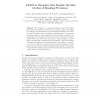Free Online Productivity Tools
i2Speak
i2Symbol
i2OCR
iTex2Img
iWeb2Print
iWeb2Shot
i2Type
iPdf2Split
iPdf2Merge
i2Bopomofo
i2Arabic
i2Style
i2Image
i2PDF
iLatex2Rtf
Sci2ools
SBP
2012
Springer
2012
Springer
Addiction Dynamics May Explain the Slow Decline of Smoking Prevalence
The prevalence of cigarette smoking in the United States has declined very slowly over the last four decades, despite much effort by multiple governmental and non-governmental institutions. Peer influence has been shown to be the largest contributing factor to the spread of smoking behavior, which suggests the use of epidemic models for understanding this phenomenon. Here we develop a structured resistance model, which is an SIS model extended to include multiple S and I states corresponding to different levels of addiction. This model exhibits a backward bifurcation, which means that once the behavior is endemic, it can be very difficult to remove entirely from the population. We do numerical experiments with the Framingham Heart Study social network to show that the resulting epicurve closely matches empirical data on the overall decline in smoking behavior.
| Added | 25 Apr 2012 |
| Updated | 25 Apr 2012 |
| Type | Journal |
| Year | 2012 |
| Where | SBP |
| Authors | Gaurav Tuli, Madhav V. Marathe, S. S. Ravi, Samarth Swarup |
Comments (0)

